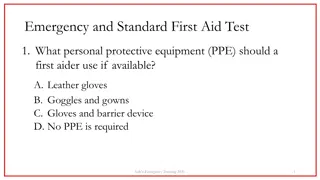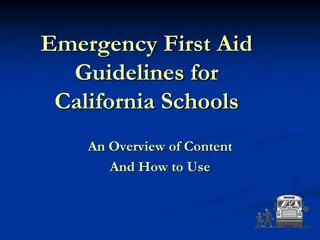First Aid Basics and Emergency Response Guidelines
Learn essential first aid procedures like assessing casualties, managing bleeding wounds, and treating burns. Follow step-by-step instructions for handling emergencies and ensuring safety. Understand when to call for professional medical assistance. Stay prepared to respond effectively in critical situations.
Download Presentation

Please find below an Image/Link to download the presentation.
The content on the website is provided AS IS for your information and personal use only. It may not be sold, licensed, or shared on other websites without obtaining consent from the author.If you encounter any issues during the download, it is possible that the publisher has removed the file from their server.
You are allowed to download the files provided on this website for personal or commercial use, subject to the condition that they are used lawfully. All files are the property of their respective owners.
The content on the website is provided AS IS for your information and personal use only. It may not be sold, licensed, or shared on other websites without obtaining consent from the author.
E N D
Presentation Transcript
CDR BOND A. DR ABC B. ABCDEF C. ABC123 D. DR SEUSS E.
A. Shout at friends to do something B. Call for an ambulance C. Check for danger before approaching D. Update the Accident Book E. Go and get your first aid supplies
A. Ambulance, Breathing, Control B. Aid, Bypass, Cardiogram C. Airway, Breathing, Circulation D. Assess, Breathing, Circulation E. American Broadcasting Corporation
The only thing you should put on a burn is cold water - keep the butter for cooking. Put the affected area under cold running water for at least 10 minutes. A. True B. False
A. Do a body check on the first casualty you see B. Take history, note signs, listen to symptoms C. Look for any external bleeding D. Open first aid box and check contents E. Check casualties wallet for identity
A. To gain Respect from your group B. Start casualty on road to recovery C. To save life and if possible, prevent injury from getting worse D. To help paramedics when they arrive E. To apply the correct dressings
If you put a bleeding wound under a tap, you wash away the body's clotting agents and make it bleed more. A. True If nothing in wound, press on it over a clean pad, bandage and raise above level of heart B. False
The object in the wound could be blocking further blood loss, so if you pull it out you could be dealing with a major haemorrhage. The aim is to build a 'bridge' over the object while keeping pressure on the wound. Apply padding to either side of the object, then bandage over without pressing on it. Call for an ambulance. A. True B. False
Tilting the head back will encourage the blood to run down the back of the throat and possibly into the stomach, inducing vomiting. Sit the person down, reassure them and pinch the tip rather than the hard bit of the nose. Discourage them from coughing or swallowing until the bleeding stops. It may be helpful to place a bowl on the floor to catch any dripping blood A. True B. False
A. It is easier to carry out a body check B. It is more comfortable when they wake up C. To assist their circulation D. To keep their airway clear and reduce risk of inhaling vomit E. In case they are in shock
A. Helps us to keep fit B. It keeps us alive: without it we die C. Allows us to think clearly D. Helps with the digestive process E. Reduces the need for medication
A. To check up their nose for any bleeding B. To assist the casualty to hear the 1st Aider C. To steady the position of the casualties head D. To make it easier to do a body check E. To open their airway fully
A. If after checking, they are NOT breathing with a history of collapse only, & no other injury B. If they are breathing, and the breathing is clear C. If they are breathing, and the breathing is noisy D. If they have choked on some food E. Never: a 1st Aider should always render 1st Aid and hope someone comes along
A. By checking for a pulse in their wrist B. By listening to their heart to feel if it is beating C. Noting a change of colour they will be very flushed D. Noting a change of colour they will be very pale E. By looking at their chest/abdomen, listening & feeling for breath on your cheek
A. Put the injured limb in cold water B. Give him an aspirin C. Apply direct pressure to the wound D. Get a sponge to clean the floor E. Ask him whether it hurts
A. Shivering; cold, pale skin B. Apathy and disorientation C. Slow and shallow breathing D. Severe thirst E. Slow and weakening pulse
A. When the casualty is scared B. When the casualty panics C. When the 1stAider doesn t know what to do D. When the casualty feels sick E. When not enough blood is supplying the vital 0rgans
A. Facial weakness; drooping eyes / mouth B. Weakness in one arm C. A sharp pain in the chest D. Slurred speech E. Dizziness, blurred vision
Get him to lay down flat Encourage him to have a tot of whiskey from his hip- flask Make him stand up and move around slowly Sit him in a comfortable position, then get help Suggest you all play twister
A. Mountain Rescue B. Cave Rescue C. Lifeboat D. Coastguard E. The AA
D Danger: R Response: AAirway: B Breathing: CCirculation: to you, others, casualties speak to casualty, gently shake, can pinch ear lobe Is blockage in throat? Is head in suitable position (tilt head back) Can the casualty breathe okay ? Is there a pulse ? If not, CPR may be required (30:2 compressions to breaths)
Preserve life the Main Aim ! Prevent further harm could be external (move them away from danger) or applying first aid techniques Promote recovery maybe as simple as applying a plaster !
F Face unable to smile, eye and/or mouth is droopy A Arm weakness, unable to raise one arm S problems understanding T Time to call 999/112 for emergency help Speech unable to speak clearly or has
Symptoms Action Shivering; cold, pale skin Spot early: keep warm Apathy & disorientation Keep/get dry Slow &shallow breathing Drink hot coffee/tea with sugar Slow &weakening pulse GET HELP
Symptoms Action Hot, dry skin Drink water Nausea & vomiting Get in shade Headaches/fainting/dizzy Fresh air GET HELP Confused or hostile May appear drunk























